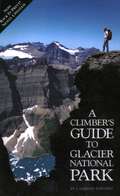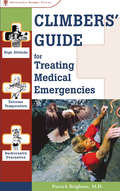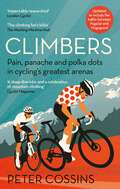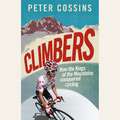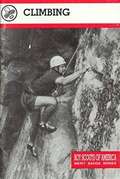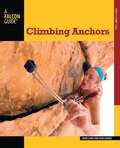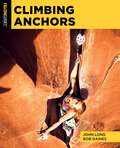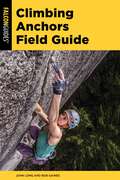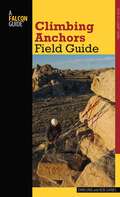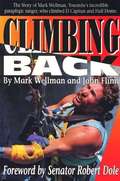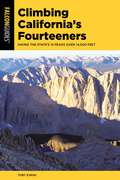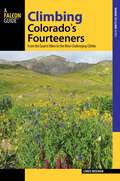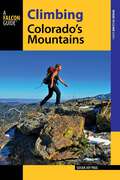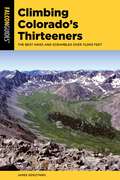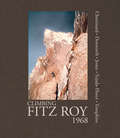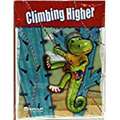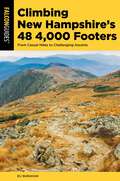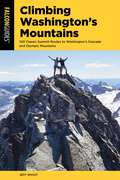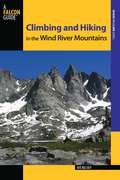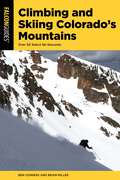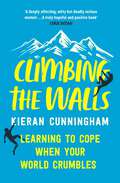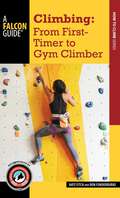- Table View
- List View
Climber's Guide to Glacier National Park (Regional Rock Climbing Series)
by J. Gordon EdwardsThis guide is considered a classic of mountaineering literature.
Climbers' Guide to Treating Medical Emergencies
by Patrick BrightonFrom pulmonary edema to bashed knuckles, physician and outdoor athlete Dr. Patrick Brighton covers everything a climber needs to know to stay well along the way. Whether bouldering the backyard or seeking shelter high atop Aconcagua, this guide gives readers simple, straight-forward advice to help handle an emergency situation.
Climbers: How the Kings of the Mountains conquered cycling
by Peter CossinsWhen, during the Pyrenean stages of the 1998 Tour de France, a journalist asked Marco Pantani why he rode so fast in the mountains, the elfin Italian, unmistakeable in the bandanna and hooped ear-rings that played up to his "Pirate" nickname, replied: "To shorten my agony."Drawing on the fervour for these men of the mountains, Climbers looks at what sets these athletes apart within the world of bike racing, about why we love and cherish them, how they make cycling beautiful, and how they see themselves and the feats they achieve.Working chronologically, Peter Cossins explores the evolution of mountain-climbing. He offers a comprehensive view of the sport, combining contemporary reports with fresh one-to-one interviews with high-profile riders from the last 50 years, such as Cyrille Guimard, Hennie Kuiper and Andy Schleck. And, unlike many other cycling books, Climbers also includes the stories of female racers across the world, from Ashleigh Moolman-Pasio and Annemiek van Vleuten to Fabiana Luperini and Amanda Spratt.Climbers analyses the personalities of these racers, highlighting the individuality of climbing as an exercise and the fundamental fact that it's a solitary challenge undertaken in relentlessly unforgiving terrain that requires unremitting effort.Captivating and iconic, Climbers is the ultimate cycling book to understand what it takes both physically and mentally to take on the sport's hardest stages.
Climbers: How the Kings of the Mountains conquered cycling
by Peter CossinsWhen, during the Pyrenean stages of the 1998 Tour de France, a journalist asked Marco Pantani why he rode so fast in the mountains, the elfin Italian, unmistakeable in the bandanna and hooped ear-rings that played up to his "Pirate" nickname, replied: "To shorten my agony."Drawing on the fervour for these men of the mountains, Climbers looks at what sets these athletes apart within the world of bike racing, about why we love and cherish them, how they make cycling beautiful, and how they see themselves and the feats they achieve.Working chronologically, Peter Cossins explores the evolution of mountain-climbing. He offers a comprehensive view of the sport, combining contemporary reports with fresh one-to-one interviews with high-profile riders from the last 50 years, such as Cyrille Guimard, Hennie Kuiper and Andy Schleck. And, unlike many other cycling books, Climbers also includes the stories of female racers across the world, from Ashleigh Moolman-Pasio and Annemiek van Vleuten to Fabiana Luperini and Amanda Spratt.Climbers analyses the personalities of these racers, highlighting the individuality of climbing as an exercise and the fundamental fact that it's a solitary challenge undertaken in relentlessly unforgiving terrain that requires unremitting effort.Captivating and iconic, Climbers is the ultimate cycling book to understand what it takes both physically and mentally to take on the sport's hardest stages.
Climbers: How the Kings of the Mountains conquered cycling
by Peter CossinsWhen, during the Pyrenean stages of the 1998 Tour de France, a journalist asked Marco Pantani why he rode so fast in the mountains, the elfin Italian, unmistakeable in the bandanna and hooped ear-rings that played up to his "Pirate" nickname, replied: "To shorten my agony."Drawing on the fervour for these men of the mountains, Climbers looks at what sets these athletes apart within the world of bike racing, about why we love and cherish them, how they make cycling beautiful, and how they see themselves and the feats they achieve.Working chronologically, Peter Cossins explores the evolution of mountain-climbing. He offers a comprehensive view of the sport, combining contemporary reports with fresh one-to-one interviews with high-profile riders from the last 50 years, such as Cyrille Guimard, Hennie Kuiper and Andy Schleck. And, unlike many other cycling books, Climbers also includes the stories of female racers across the world, from Ashleigh Moolman-Pasio and Annemiek van Vleuten to Fabiana Luperini and Amanda Spratt.Climbers analyses the personalities of these racers, highlighting the individuality of climbing as an exercise and the fundamental fact that it's a solitary challenge undertaken in relentlessly unforgiving terrain that requires unremitting effort.Captivating and iconic, Climbers is the ultimate cycling book to understand what it takes both physically and mentally to take on the sport's hardest stages.(p) 2021 Octopus Publishing Group
Climbing (Merit Badge Series)
by Boy Scouts of AmericaThis book introduces scouts to the adventure of climbing and rappelling. It covers equipment, safety, techniques, etc.
Climbing (Merit Badge)
by Boy Scouts of America StaffA handbook for earning the Boy Scout merit badge in climbing that covers risk management, first aid, clothing, equipment, rappelling, ethics, and more; and includes a list of resources.
Climbing Anchors (How To Climb Series)
by John Long Bob GainesThis completely revised and updated edition with all new color photos brings together in a single volume the anchoring systems most popular among climbers. Most climbers today learn their craft on artificial climbing walls and on sport routes with fixed protection. Their first efforts to lead on trad routes often come as a rude shock--they find that they haven't the skills and training to safeguard the climb or to set up solid belays. This new edition of Climbing Anchors is the climber's complete and authoritative source of information on protection, from fundamental knots to sophisticated rigging and equalizing skills.
Climbing Anchors (How To Climb Series)
by John Long Bob GainesThis completely revised and updated edition, illustrated with 359 color photographs and drawings, brings together in a single volume the anchoring systems most popular among climbers. If you&’re new to trad climbing, this book details the necessary skills needed to make safe gear placements and build solid and efficient anchor systems, based on simple guidelines. This new edition of Climbing Anchors is the climber&’s complete and authoritative source of information on placement and evaluation criteria for nuts and camming devices. Included are assessment principles for bolts and a thorough discussion of how to rig and assess toprope, rappel, single-pitch, and multi-pitch anchor systems. Climbing Anchors covers it all- from fundamental knots to sophisticated rigging and load distribution skills.Updated fourth edition includes:Over 150 additional new photographsThe latest equipment and techniques for anchoringIntroduces the new STRANDS principle for evaluating any anchor systemCorrect application of girth hitch masterpoint anchorsDispels old myths about shock loading and equalization with new guidelines
Climbing Anchors Field Guide (Climbing Mountains Series)
by John Long Bob GainesDesigned for quick use by climbers on site, this field guide is up to date with essential knowledge every climber can depend on to easily evaluate climbing anchors.Illustrated with 266 photos, drawings, and diagrams, key fundamentals are detailed with bullet points, and assessment guidelines for nuts, cams, and anchor systems are spelled out in easy to remember acronyms, simplifying the most important and critical guidelines every trad climber should know. Climbing Anchors Field Guide is the definitive reference manual for concise information on protection and anchor systems, including bolt anchors, rappel anchors, toprope anchors, and anchors for both single-pitch and multi-pitch climbing, all in a condensed and easy to read format.
Climbing Anchors Field Guide (How To Climb Series)
by John Long Bob GainesWith more than 100 full-color photos and detailed captions showing how to create safe and simple rock-climbing anchoring systems, this is a take-to-the-crag companion book to our huge-selling Climbing Anchors.Designed for quick use by climbers on site, this book shows how to properly place and configure natural anchors, passive chocks, mechanical chocks, fixed gear, knots, belay anchors, toprope anchors and rappel anchors. This field guide is up to date with the essential knowledge every climber can depend on.
Climbing Back
by Mark Wellman John FinnThere is almost no limit to what we can accomplish--except perhaps in our own minds. Mark Wellman's relentless struggle to survive a disabling accident to become a park ranger and an accomplished wheelchair athlete, and ultimately to climb the sheer granite faces of Yosemite's El Capitan and Half Dome challenges all of us to continue to strive toward loftier goals. Foreword by Senator Robert Dole.
Climbing California's Fourteeners: Hiking the State's 15 Peaks Over 14,000 Feet (Climbing Mountains Series)
by Toby EvansFrom the southernmost peak of Mt. Langley to Mt. Shasta in the north, California&’s fifteen peaks of 14,000 feet or more are some of the most challenging and beautiful mountains in the country. Over the past decade the rise of endurance activities (including obstacle racing) and the popularity of reality television have increased the popularity of these daunting climbs (California&’s Fourteeners have been featured on The Amazing Race, Man vs. Wild, and Django Unchained).No matter the skill level, this book will lay out the plans and logistics to allow every climber a positive experience. Each of the mountains will be broken down based on the technical skills needed, a recommended list of gear and equipment, how to prepare for rapidly changing weather and trail conditions, and a general timeframe needed to reach each summit.
Climbing Colorado's Fourteeners: From the Easiest Hikes to the Most Challenging Climbs (Regional Hiking Series)
by Chris MeehanTaking on one of Colorado&’s 53 fourteeners—from stately Longs Peak and the iconic Maroon Bells to the easy to access Mt. Bierstadt—is becoming a pilgrimage for Colorado&’s residents and its visitors. While more people than ever are climbing them, there&’s still a dearth of good information about each mountain and its surrounding areas. Hiking Colorado&’s Fourteeners fills that gap by informing adventurers—from the freshly-booted novice to the grizzled mountaineer—about each of Colorado&’s iconic mountains over 14,000 feet tall.
Climbing Colorado's Mountains (Climbing Mountains Series)
by Susan Joy PaulClimbing Colorado&’s Mountains covers 100 peaks in Colorado across a range of abilities, including 12ers, 13ers, and 14ers. This guide includes detailed hike and climb descriptions, miles and maps, and color photos with ascent and descent routes for the most popular peaks in the state. Climbing descriptions also include history, local trivia, and trailhead GPS coordinates.
Climbing Colorado's Thirteeners: The Best Hikes and Scrambles over 13,000 Feet
by James DziezynskiThis book is a collection of the very best non-technical hikes and scrambles on Colorado's 13,000-foot mountains. It will showcase 50 select routes on the most exciting, beautiful, and adventurous of the 637 officially recognized thirteeners. A balance of difficulty will roughly be divided into thirds: easier (about 25% of the routes), modest (50%), and difficult (25%). While the guide will cover the entire state of Colorado, there will be a slight bias toward summits within a two-hour drive of the Denver/Boulder metro area. Each of the 50 chapters includes full-color photography and maps. None of the routes are harder than class 3, making this guide suitable to hikers of all skill levels, with no need to use technical mountaineering gear. Detailed write-ups include accurate driving directions, at-a-glance stats for the peak, a turn-by-turn description of the primary route, optional route info, and when relevant, interesting history or stories about the featured peak. Fees, permits, and an index with info such as thirteener lists, helpful USFS contacts, hiking groups, and online resources are also provided.
Climbing Fitz Roy, 1968
by Lito Tejada-Flores Chris Jones Yvon Chouinard Doug Tompkins Dick DorworthThis book features rare, once-thought-lost photos of the 1968 first ascent of the California Route on Cerro Fitz Roy, the third ascent of the mountain. With accompanying retrospective essays. Climbing Fitz Roy,1968, presents photo documentation of the climb, places it in the social and climbing context of the times, and reflects how this momentous trip influenced the lives of those involved, and in a greater context, the lives of so many others.
Climbing New Hampshire's 48 4,000 Footers: From Casual Hikes to Challenging Ascents (Regional Hiking Series)
by Eli BurakianTaking on one of New Hampshire&’s 48 4,000 footers is becoming a pilgrimage for New Hampshire residents and its visitors. While more people than ever are hiking them, there&’s still a dearth of good information about each mountain and its surrounding areas. Climbing New Hampshire&’s 48 4,000 Footers fills that gap by informing adventurers—from the freshly-booted novice to the grizzled mountaineer—about each of New Hampshire&’s 48 iconic mountains that top out at over 4,000 feet.Look inside to find:Multiple routes up each mountainNational Geographic mapsGPS coordinatesFull-color photography
Climbing Washington's Mountains: 100 Classic Summit Routes to Washington's Cascade and Olympic Mountains (Climbing Mountains Series)
by Jeff SmootThis select guide includes detailed, easy to follow directions to climbing 100 of Washington&’s most visible, historically significant, and interesting mountains with summits over 5,000 feet. From introductory level off-trail summit hikes and scrambles to multi-pitch alpine rock and high volcano climbs, this guide is suitable for beginning scramblers and alpine rock climbers as well as more experienced climbers. Blending all types of climbing at all levels of difficulty, you'll find routes to popular scrambling peaks such as Mount Si, classic alpine rock peaks such as Prusik Peak, and to big volcanoes including Mount Rainier. Fully revised and updated, this book has been praised by scramblers, alpine rock climbers, volcano climbers, and trip leaders alike as being an accurate, user-friendly guide with superb, easy-to-follow route descriptions and drawings, to the summits of the mountains that people actually want to climb.
Climbing and Hiking in the Wind River Mountains (Climbing Mountains Series)
by Joe KelseyNow completely updated and revised with new color photos and topos, this guidebook is the ultimate resource to technical climbing routes, hiking trails, and peak-bagging routes in Wyoming's Wind River Range, a popular playground for backcountry enthusiasts and alpine rock climbers. More than 200 new climbing routes have been completed in the Wind Rivers since this book was last published in 1994, and this guide is the only comprehensive collection of information available to climbers. Includes hiking and climbing information for these areas: Ross LakesGreen RiverDinwoody GlacierPeak LakeTitcomb BasinAlpine LakesMiddle Fork LakeEast Fork ValleyBaptiste LakeCirque of the TowersDeep LakeSouth Pass
Climbing and Skiing Colorado's Mountains: Over 50 Select Ski Descents
by Brian Miller Ben ConnersClimbing and Skiing Colorado&’s Mountains is a select guidebook to 50 of the most classic, aesthetic, and iconic backcountry ski descents in the state of Colorado. The book provides accurate information to backcountry skiers and snowboarders, including overviews, maps, photos, and route descriptions for each of the selected 50 descents, while at the same time spurring the reader on to investigate peaks and areas outside of those featured in the book. Unlike other guidebooks, Climbing and Skiing Colorado's Mountains focus on peaks of all elevations located in all ranges throughout the state, including many 13ers and 14ers but also some smaller, more accessible peaks, representing a comprehensive mix of some of the best backcountry skiing Colorado has to offer.
Climbing the Volcano: A Journey in Haiku
by Curtis ManleyThrough haiku, a young boy narrates his family&’s invigorating hike to the peak of Oregon&’s South Sister volcano.For centuries, haiku has offered meditation on the grace and majesty of nature. In Climbing the Volcano, old meets new as a young protagonist uses the poetic form to voice his wonder. Trekking uphill, the family encounters tiny toads, colorful butterflies, soaring birds of prey, and so much more to see, do, and feel. dormant volcano—but at sunrise each dayit blazesClimbing the Volcano is a call to adventure in the natural world, and a wonderful introduction to poetic forms. Young readers will be inspired to summit their own peaks and to find their own voices to share what they discover there. Whether you live in the shadow of a volcano, amid sprawling flatlands, or anywhere in between, Climbing the Volcano invites you to get out there and explore. Jennifer K. Mann&’s breezy, childlike artwork harmonizes with Curtis Manley&’s poetry to detail this mesmerizing Pacific Northwest journey.A Junior Library Guild Gold Standard Selection
Climbing the Walls
by Kieran CunninghamWhen mountains are your salvation, what keep your mental weather calm and free of storms, how do you cope if they&’re out of reach? After spending a decade restlessly globetrotting in search of a way of life that worked for him, journalist Kieran Cunningham alighted on Sondrio, a small town in Lombardy, Italy. A stone&’s throw from the Alps, there he found the perfect combination of fresh mountain air, a strong network of local friends and lots of climbing. Finally he was able to accept and manage his diagnosis of Bipolar 1. And then Lombardy found itself the European epicentre of Covid-19 and subject to the strictest of lockdowns. What does a climber do when his beloved peaks are off limits? When he&’s only permitted to leave the house for his weekly sanctioned grocery shop? When all the things that help him maintain his delicate equilibrium are taken away? As Kieran feels his mental health begin to crumble, he looks desperately for something he can climb to help rid him of his excess energy and hopefully get him back on track. Kieran finds himself navigating the walls of his house over and over while gazing at the mountain ranges so tantalisingly close. He dreams of that first euphoric climb – alone in the clouds, tired, happy, sated. Climbing the Walls is a memoir about mental health and the power of nature and exercise. It&’s both a devastatingly honest account of living with Bipolar 1 and a love song to small-town Italian life and the high places that keep him healthy.
Climbing: From First-Timer to Gym Climber (How To Climb Series)
by Nate Fitch Ron FunderburkeThe first in a progression series aimed at beginner climbers, Climbing: From First-Timer to Gym Climber walks you through your first time trying to rock climb and offers basic instruction on the fundamental skills needed to get off the ground and onto the wall.
